Effects of Different Silicon Sources on the Properties of Geopolymer Planting Concrete Mixed with Red Mud
Abstract
1. Introduction
2. Experimental Matrix Plan
2.1. Materials Used
2.2. Sample Preparation and Replicates
2.3. Laboratory Testing Methods
2.3.1. Mineralogical Characteristics and Microstructure
2.3.2. Fluidity
2.3.3. Compressive Strength
2.3.4. Pore Characteristics
2.3.5. Soil Alkalinity
2.3.6. Status of the Plant Growth
2.3.7. Finite Element Modeling
3. Results, Analysis, and Discussions
3.1. Mineralogical Characteristics and Microstructure
3.1.1. Mineralogical Characteristics Analysis
3.1.2. Microstructure Analysis
3.2. Fluidity Analysis of the Geopolymer Slurry
3.3. Analysis of the PC Mechanical Properties
3.4. Analysis of the PC Pore Characteristics
3.4.1. Connected Porosity
3.4.2. Planting Porosity
3.5. Analysis of the Soil Alkalinity
3.6. Analysis of the PC Planting Performance
3.7. Slope Stability Finite Element (FE) Analysis
4. Conclusions and Recommendations
- When the content of SF and DA is 10% and 5%, respectively, the PC compressive strength quantittatively reached its best performance and increased with an increase in the A/P ratio;
- The pore characteristics of PC were found to be mainly related to the fluidity of geopolymer slurry. For good PC pore characteristics, the fluidity of the mortar should be 112~128 mm. When the SF and DA contents are less than 10% and 5%, respectively, their morphological effect was observed to significantly improve the fluidity of the slurry. However, if the content continues to increase above these levels, the high water absorption capacity of SF and DA, along with the high plasticity of DA, will significantly retard the flow of the slurry, i.e., reduce slurry fluidity;
- A/P was found to be the main factor affecting the soil alkalinity. When the A/P ratio is not higher than 0.2, adding SF and DA can lower the soil pH value to less than 9. In the early stages of plant growth, soil alkalinity was observed to be the main influencing factor. The later growth of the plants was oberseved to be mostly affected by the PC pore characteristics;
- Considering the overall performance of PC, the optimum A/P ratio was found to be 0.2 at 10% SF and 5% DA;
- Through finite element analysis of the PC slope stability, it was found that geopolymer modifed PC can effectively improve the slope stability, whilst also contributing to environmental protection and beautification. In general, the study has demonstrated that it is feasible to prepare PC with red mud geopolymer instead of OPC and concurrently use it in slope protection applications.
Author Contributions
Funding
Institutional Review Board Statement
Informed Consent Statement
Data Availability Statement
Conflicts of Interest
References
- Lai, H.; Du, J.; Zhou, C.; Liu, Z. Experimental Study on Ecological Performance Improvement of Sprayed Planting Concrete Based on the Addition of Polymer Composite Material. Int. J. Environ. Res. Public Health 2022, 19, 12121. [Google Scholar] [CrossRef]
- Kolesnikova, O.; Syrlybekkyzy, S.; Fediuk, R.; Yerzhanov, A.; Nadirov, R.; Utelbayeva, A.; Agabekova, A.; Latypova, M.; Chepelyan, L.; Volokitina, I.; et al. Thermodynamic Simulation of Environmental and Population Protection by Utilization of Technogenic Tailings of Enrichment. Materials 2022, 15, 6980. [Google Scholar] [CrossRef] [PubMed]
- Amran, M.; Fediuk, R.; Murali, G.; Vatin, N.; Karelina, M.; Ozbakkaloglu, T.; Krishna, R.S.; Kumar, A.S.; Kumar, D.S.; Mishra, J. Rice Husk Ash-Based Concrete Composites: A Critical Review of Their Properties and Applications. Crystals 2021, 11, 168. [Google Scholar] [CrossRef]
- Kolesnikova, O.; Vasilyeva, N.; Kolesnikov, A.; Zolkin, A. Optimization of raw mix using technogenic waste to produce cement clinker. Min. Inf. Anal. Bull. 2022, 10-1, 103–115. [Google Scholar] [CrossRef]
- Shobeiri, V.; Bennett, B.; Xie, T.; Visintin, P. A comprehensive assessment of the global warming potential of geopolymer concrete. J. Clean. Prod. 2021, 297, 126669. [Google Scholar] [CrossRef]
- Groves, M.C.E.; Sasonow, A. Uhde EnviNOx® technology for NOX and N2O abatement: A contribution to reducing emissions from nitric acid plants. J. Integr. Environ. Sci. 2010, 7, 211–222. [Google Scholar] [CrossRef]
- Elizondo-Martínez, E.-J.; Andrés-Valeri, V.-C.; Jato-Espino, D.; Rodriguez-Hernandez, J. Review of porous concrete as multifunctional and sustainable pavement. J. Build. Eng. 2020, 27, 100967. [Google Scholar] [CrossRef]
- Naqi, A.; Jang, J.G. Recent Progress in Green Cement Technology Utilizing Low-Carbon Emission Fuels and Raw Materials: A Review. Sustainability 2019, 11, 537. [Google Scholar] [CrossRef]
- Qaidi, S.; Tayeh, B.A.; Isleem, H.F.; de Azevedo, A.R.; Ahme, H.U.; Emad, W. Sustainable utilization of red mud waste (bauxite residue) and slag for the production of geopolymer composites: A review. Case Stud. Constr. Mater. 2022, 16, e00994. [Google Scholar] [CrossRef]
- Almutairi, A.L.; Tayeh, B.A.; Adesina, A.; Isleem, H.F.; Zeyad, A.M. Potential applications of geopolymer concrete in construction: A review. Case Stud. Constr. Mater. 2021, 15, e00733. [Google Scholar] [CrossRef]
- Bhushan, J.B.; Thamer, A.; Assaedi, H.; Rodrigue, K.C. Geopolymer concrete with metakaolin for sustainability: A comprehensive review on raw material’s properties, synthesis, performance, and potential application. Environ. Sci. Pollut. Res. Int. 2022. [Google Scholar] [CrossRef]
- Silveira, N.C.G.; Martins, M.L.F.; Bezerra, A.C.S.; Araújo, F.G.S. Red Mud from the Aluminium Industry: Production, Characteristics, and Alternative Applications in Construction Materials—A Review. Sustainability 2021, 13, 12741. [Google Scholar] [CrossRef]
- Lu, Y.; Liu, X.; Zhang, Z.; Wang, Y.; Xue, Y.; Wang, M. Applications of Red Mud as a Masonry Material: A Review. Bull. Environ. Contam. Toxicol. 2022, 109, 215–227. [Google Scholar] [CrossRef] [PubMed]
- Lima, M.S.S.; Hajibabaei, M.; Thives, L.P.; Haritonovs, V.; Buttgereit, A.; Queiroz, C.; Gschösser, F. Environmental potentials of asphalt mixtures fabricated with red mud and fly ash. Road Mater. Pavement Des. 2021, 22, S690–S701. [Google Scholar] [CrossRef]
- Zhang, J.; Yao, Z.; Wang, K.; Wang, F.; Jiang, H.; Liang, M.; Wei, J.; Airey, G. Sustainable utilization of bauxite residue (Red Mud) as a road material in pavements: A critical review. Constr. Build. Mater. 2021, 270, 121419. [Google Scholar] [CrossRef]
- Pan, Z.; Li, D.; Yu, J.; Yang, N. Properties and microstructure of the hardened alkali-activated red mud–slag cementitious material. Cem. Concr. Res. 2003, 33, 1437–1441. [Google Scholar] [CrossRef]
- Kumar, A.; Saravanan, T.J.; Bisht, K.; Kabeer, K.S.A. A review on the utilization of red mud for the production of geopolymer and alkali activated concrete. Constr. Build. Mater. 2021, 302, 124170. [Google Scholar] [CrossRef]
- Zhang, W.; Liu, X.; Wang, Y.; Li, Z.; Li, Y.; Ren, Y. Binary reaction behaviors of red mud based cementitious materialHydration characteristics and Na(+) utilization. J. Hazard. Mater. 2021, 410, 124592. [Google Scholar] [CrossRef]
- Dimas, D.D.; Giannopoulou, I.P.; Panias, D. Utilization of alumina red mud for synthesis of inorganic polymeric materials. Miner. Process. Extr. Metall. Rev. 2009, 30, 211–239. [Google Scholar] [CrossRef]
- Sun, Z.; Tang, Q.; Xakalashe, B.S.; Fan, X.; Gan, M.; Chen, X.; Ji, Z.; Huang, X.; Friedrich, B. Mechanical and environmental characteristics of red mud geopolymers. Constr. Build. Mater. 2022, 321, 125564. [Google Scholar] [CrossRef]
- Bai, Y.; Guo, W.; Wang, X.; Pan, H.; Zhao, Q.; Wang, D. Utilization of municipal solid waste incineration fly ash with red mud-carbide slag for eco-friendly geopolymer preparation. J. Clean. Prod. 2022, 340, 130820. [Google Scholar] [CrossRef]
- Qin, L.; Nie, Q.; Zhang, H.; Jia, X.; Zhang, C. Laboratory experimental study on red mud geopolymer used as road subgrade materials. E3S Web Conf. 2021, 261, 02043. [Google Scholar] [CrossRef]
- Zhao, X.; Liu, C.; Zuo, L.; Wang, L.; Zhu, Q.; Wang, M. Investigation into the effect of calcium on the existence form of geopolymerized gel product of fly ash based geopolymers. Cem. Concr. Compos. 2019, 103, 279–292. [Google Scholar] [CrossRef]
- Chen, X.; Zhang, J.; Lu, M.; Chen, B.; Gao, S.; Bai, J.; Zhang, H.; Yang, Y. Study on the effect of calcium and sulfur content on the properties of fly ash based geopolymer. Constr. Build. Mater. 2022, 314, 125650. [Google Scholar] [CrossRef]
- Liang, X.; Ji, Y. Mechanical properties and permeability of red mud-blast furnace slag-based geopolymer concrete. SN Appl. Sci. 2021, 3, 23. [Google Scholar] [CrossRef]
- Sevinç, A.H.; Durgun, M.Y. Properties of high-calcium fly ash-based geopolymer concretes improved with high-silica sources. Constr. Build. Mater. 2020, 261, 120014. [Google Scholar] [CrossRef]
- Liu, H.B.; Luo, G.B.; Wang, L.H.; Gong, Y.F. Strength Time-Varying and Freeze-Thaw Durability of Sustainable Pervious Concrete Pavement Material Containing Waste Fly Ash. Sustainability 2019, 11, 176. [Google Scholar] [CrossRef]
- Rief, A.Y.; Abdullah; Husaini; Muttaqin, H. Characteristics of reactive powder concrete comprising synthesized rice husk ash and quartzite powder. J. Clean. Prod. 2022, 375, 134154. [Google Scholar] [CrossRef]
- Hasan, M.; Saidi, T.; Muyasir, A.; Alkhaly, Y.R.; Muslimsyah, M. Characteristic of calcined diatomaceous earth from Aceh Besar District—Indonesia as cementitious binder. IOP Conf. Ser. Mater. Sci. Eng. 2020, 933, 012008. [Google Scholar] [CrossRef]
- Taufiq, S.; Muttaqin, H. The effect of partial replacement of cement with diatomaceous earth (DE) on the compressive strength, absorption of mortar. J. King Saud Univ. Eng. Sci. 2020, 34, 250–259. [Google Scholar] [CrossRef]
- Hasan, M.; Saidi, T.; Husaini, H. Properties and microstructure of composite cement paste with diatomaceous earth powder (DEP) from Aceh Besar district—Indonesia. Asia-Pac. J. Sci Technol. 2021, 27, 27. [Google Scholar] [CrossRef]
- Zhao, Y.; Zhang, B.; He, F.; Meng, F.; Yang, S.; Wang, Q.; Zhu, W. Effects of Dosage and Type of GGBS on the Mechanical Properties of a Hybrid Red-Mud Geopolymer. J. Mater. Civ. Eng. 2023, 35, 04023008. [Google Scholar] [CrossRef]
- Li, J.; Zhang, Y.; Liu, G.; Peng, X. Preparation and performance evaluation of an innovative pervious concrete pavement. Constr. Build. Mater. 2017, 138, 479–485. [Google Scholar] [CrossRef]
- Risson, K.D.B.D.S.; Sandoval, G.F.; Pinto, F.S.C.; Camargo, M.; De Moura, A.C.; Toralles, B.M. Molding procedure for pervious concrete specimens by density control. Case Stud. Constr. Mater. 2021, 15, e00619. [Google Scholar] [CrossRef]
- Anburuvel, A.; Subramaniam, D.N. Influence of aggregate gradation and compaction on compressive strength and porosity characteristics of pervious concrete. Int. J. Pavement Eng. 2022, 14, 1–14. [Google Scholar] [CrossRef]
- Second Highway Survey and Design Institute of the Ministry of Communications; Highway Science Research Institute of the Ministry of Communications. Test Specification for Cement and Cement Concrete in Highway Engineering Industry Standard—Traffic; Ministry of Transport of the People’s Republic of China: Beijing, China, 2005; Volume JTG E30-2005, p. 152. [Google Scholar]
- JC/T 2557-2020; Planting Concrete. Ministry of Industry and Information Technology of the People’s Republic of China: Beijing, China, 2020.
- Jang, J.G.; Lee, N.K.; Lee, H.K. Fresh and hardened properties of alkali-activated fly ash/slag pastes with superplasticizers. Constr. Build. Mater. 2014, 50, 169–176. [Google Scholar] [CrossRef]
- Liang, G.; Zhu, H.; Li, H.; Liu, T.; Guo, H. Comparative study on the effects of rice husk ash and silica fume on the freezing resistance of metakaolin-based geopolymer. Constr. Build. Mater. 2021, 293, 123486. [Google Scholar] [CrossRef]
- Serhan, İ.; Ahmet, Ö. Investigation of mechanical properties, high-temperature resistance and microstructural properties of diatomite-containing geopolymer mortars. Arabian J. Geosci. 2022, 15, 502. [Google Scholar] [CrossRef]
- Ankur, G.; Nakul, G.; Kumar, S.K. Mechanical and Durability Characteristics Assessment of Geopolymer Composite (GPC) at Varying Silica Fume Content. J. Compos. Sci. 2021, 5, 237. [Google Scholar] [CrossRef]
- Huang, G.; Ji, Y.; Li, J.; Hou, Z.; Dong, Z. Improving strength of calcinated coal gangue geopolymer mortars via increasing calcium content. Constr. Build. Mater. 2018, 166, 760–768. [Google Scholar] [CrossRef]
- Elisabeth, B. Possible role of soil alkalinity in plant breeding for salt-tolerance. Biol. Lett. 2013, 9, 20130566. [Google Scholar] [CrossRef]
- Gong, C.; Zhou, X.; Ji, L.; Dai, W.; Lu, L.; Cheng, X. Effects of limestone powders on pore structure and physiological characteristics of planting concrete with sulfoaluminate cement. Constr. Build. Mater. 2018, 162, 314–320. [Google Scholar] [CrossRef]
- Gong, C.; Zhou, X.; Dai, W.; Liu, Y.; Lu, L.; Cheng, X. Effects of carbamide on fluidity and setting time of sulphoaluminate cement and properties of planting concrete from sulphoaluminate cement. Constr. Build. Mater. 2018, 182, 290–297. [Google Scholar] [CrossRef]
- Simulia, D.S. Abaqus, CAE Users Manual; Dassault Systemes Simulia Corp: Providence, RI, USA, 2007. [Google Scholar]
- Hu, X.; Faruk, A.N.; Zhang, J.; Souliman, M.I.; Walubita, L.F. Effects of tire inclination (turning traffic) and dynamic loading on the pavement stress–strain responses using 3-D finite element modeling. Int. J. Pavement Res. Technol. 2017, 10, 304–314. [Google Scholar] [CrossRef]
- Mabrouk, G.M.; Elbagalati, O.S.; Dessouky, S.; Fuentes, L.; Lubinda, F. 3D-finite element pavement structural model for using with traffic speed deflectometers. Int. J. Pavement Eng. 2021, 23, 4065–4079. [Google Scholar] [CrossRef]
- Li, J.; Zhang, J.; Ni, S.; Liu, L.; Walubita, L.F. Mechanical performance and environmental impacts of self-compacting concrete with recycled demolished concrete blocks. J. Clean. Prod. 2021, 293, 126129. [Google Scholar] [CrossRef]
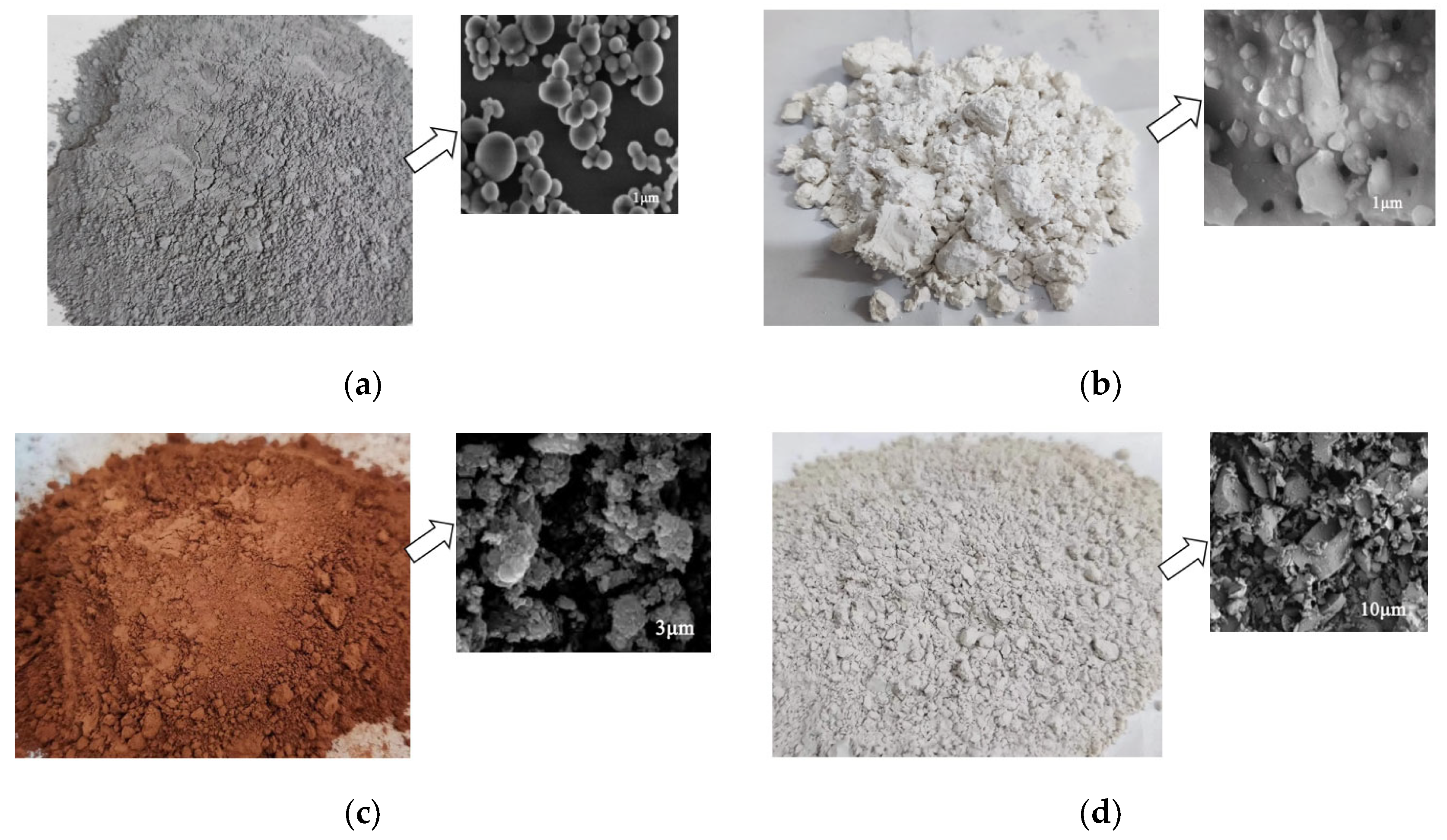
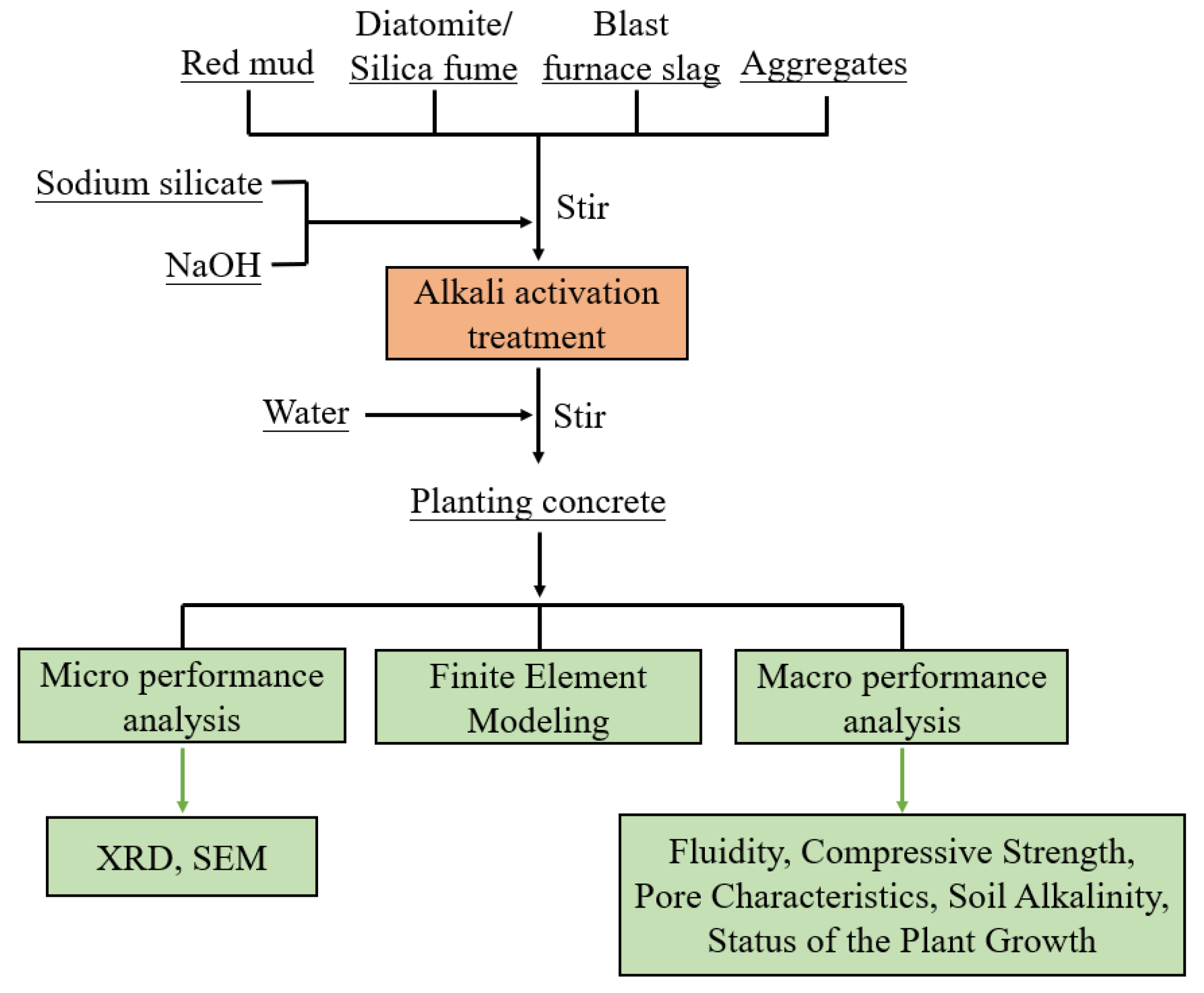

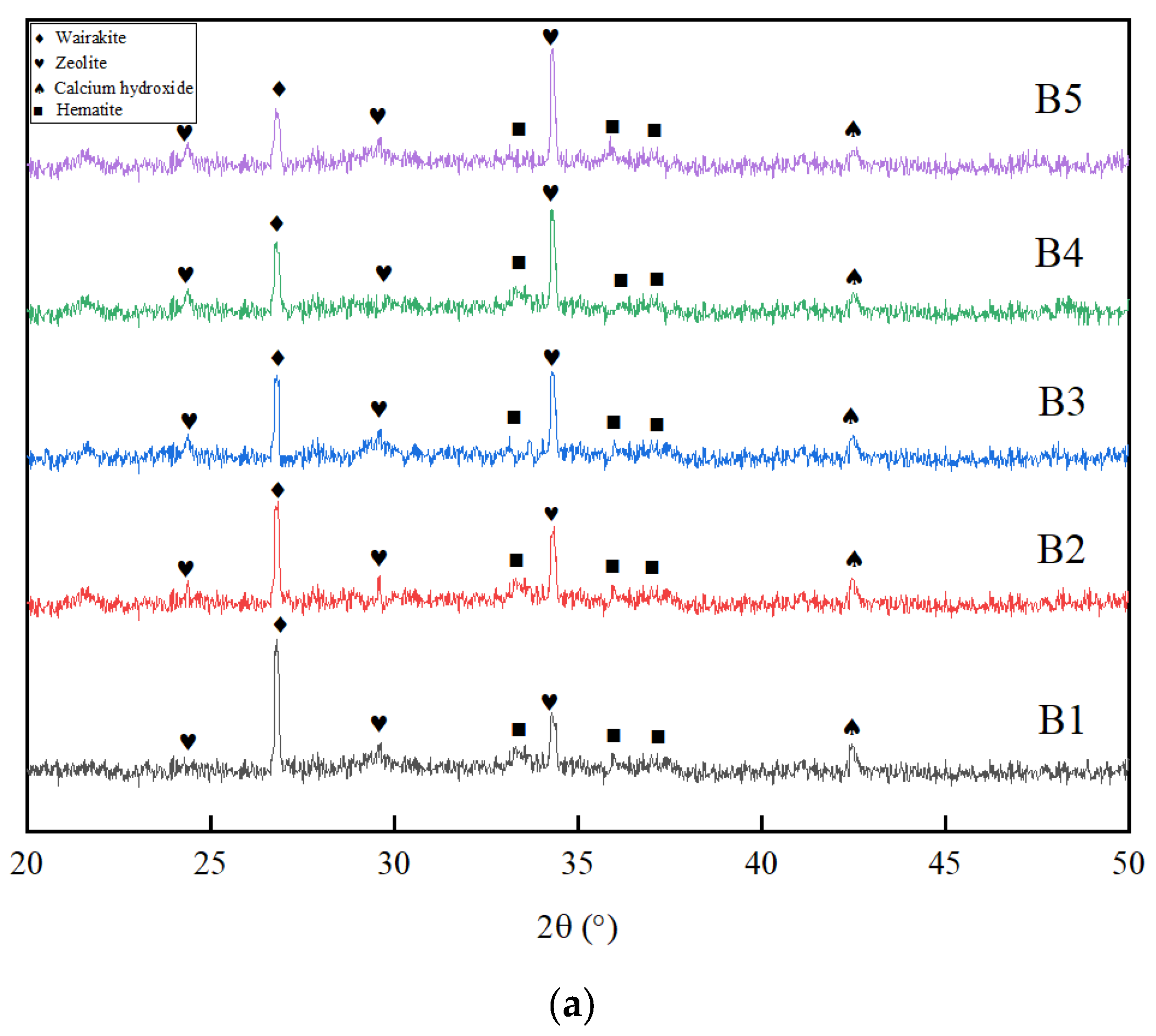
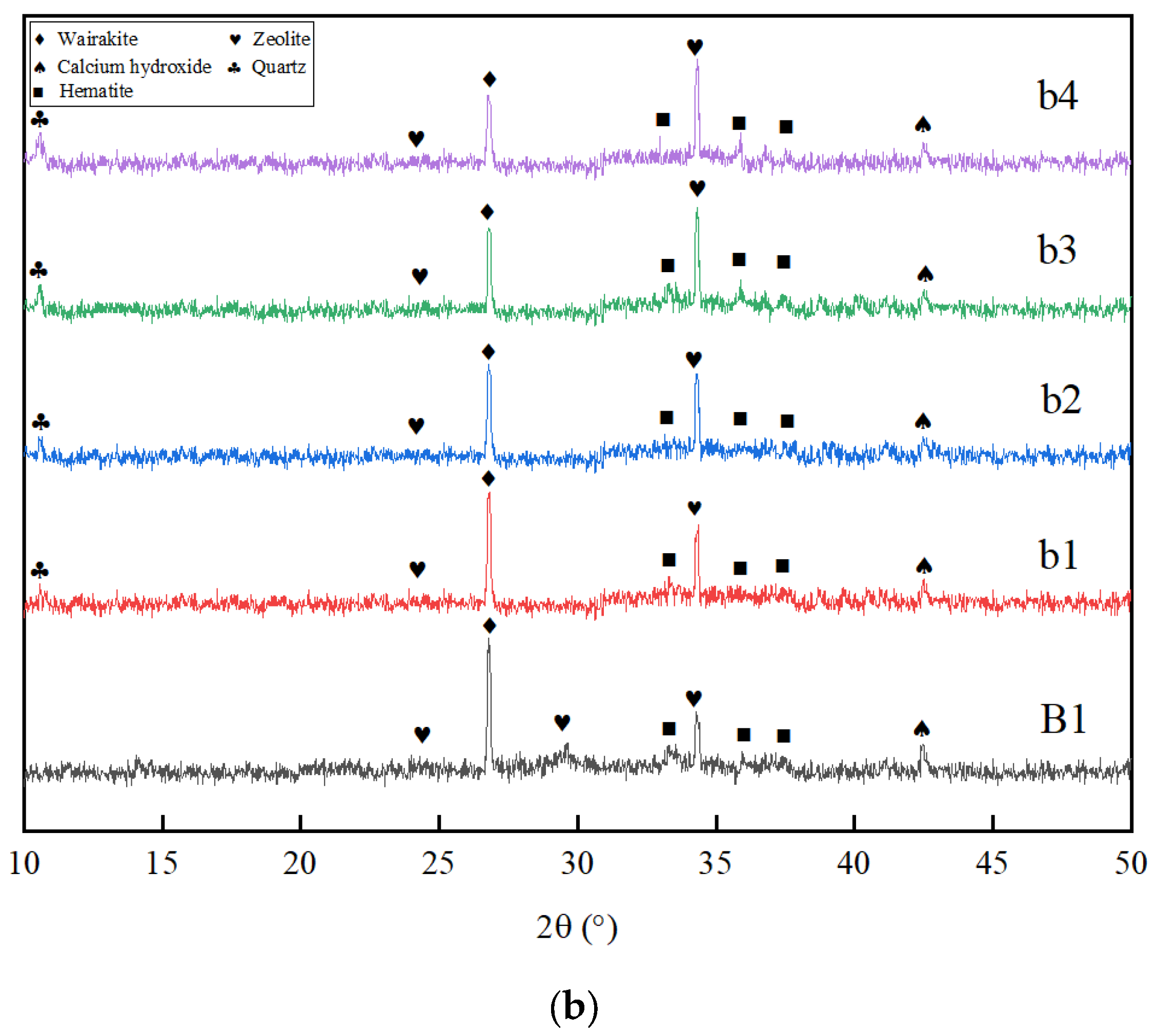

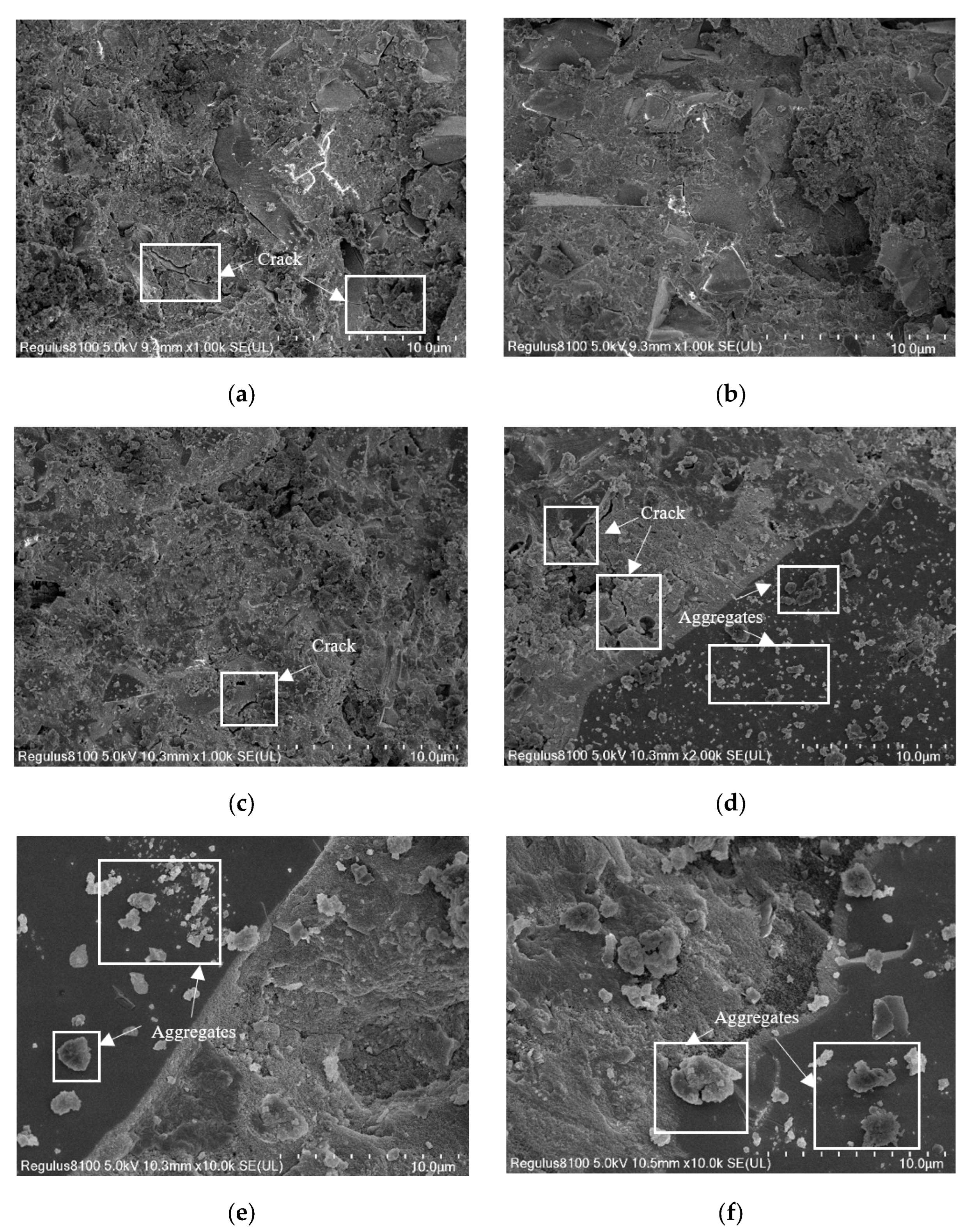
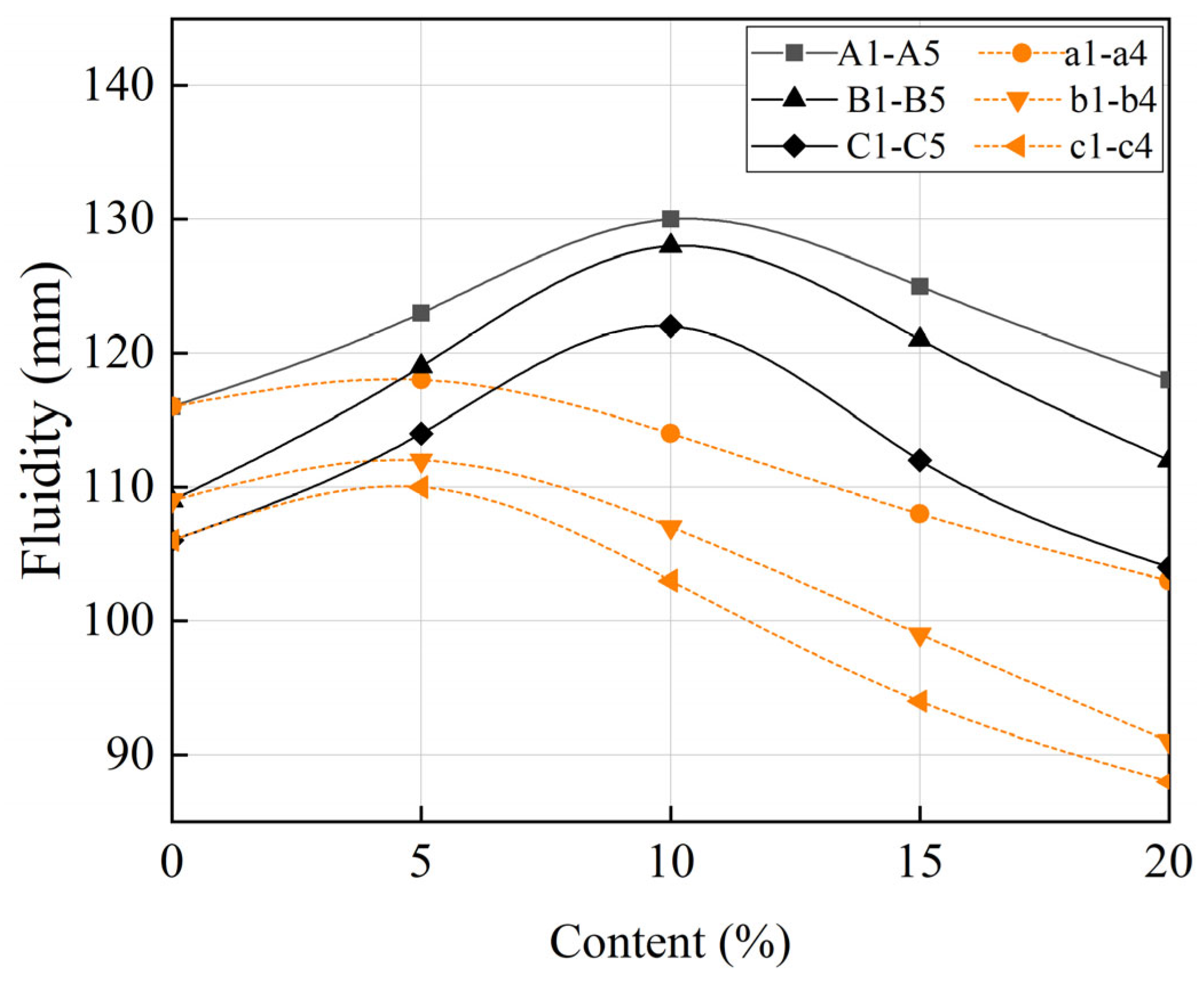

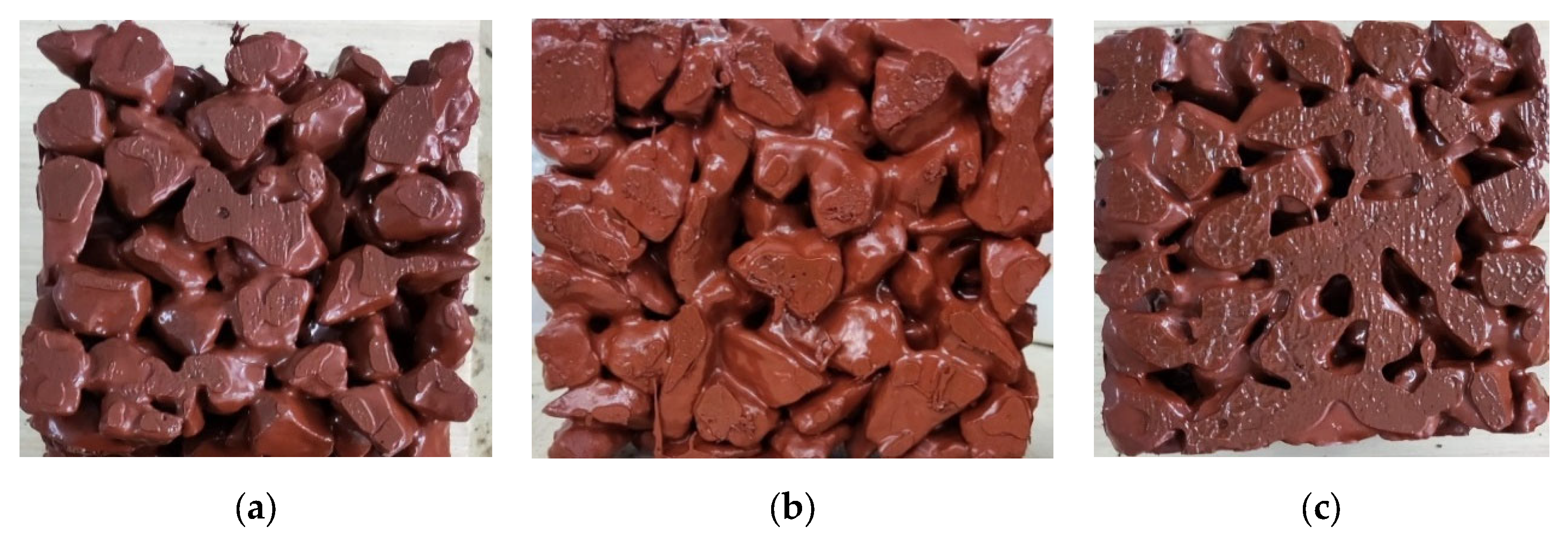
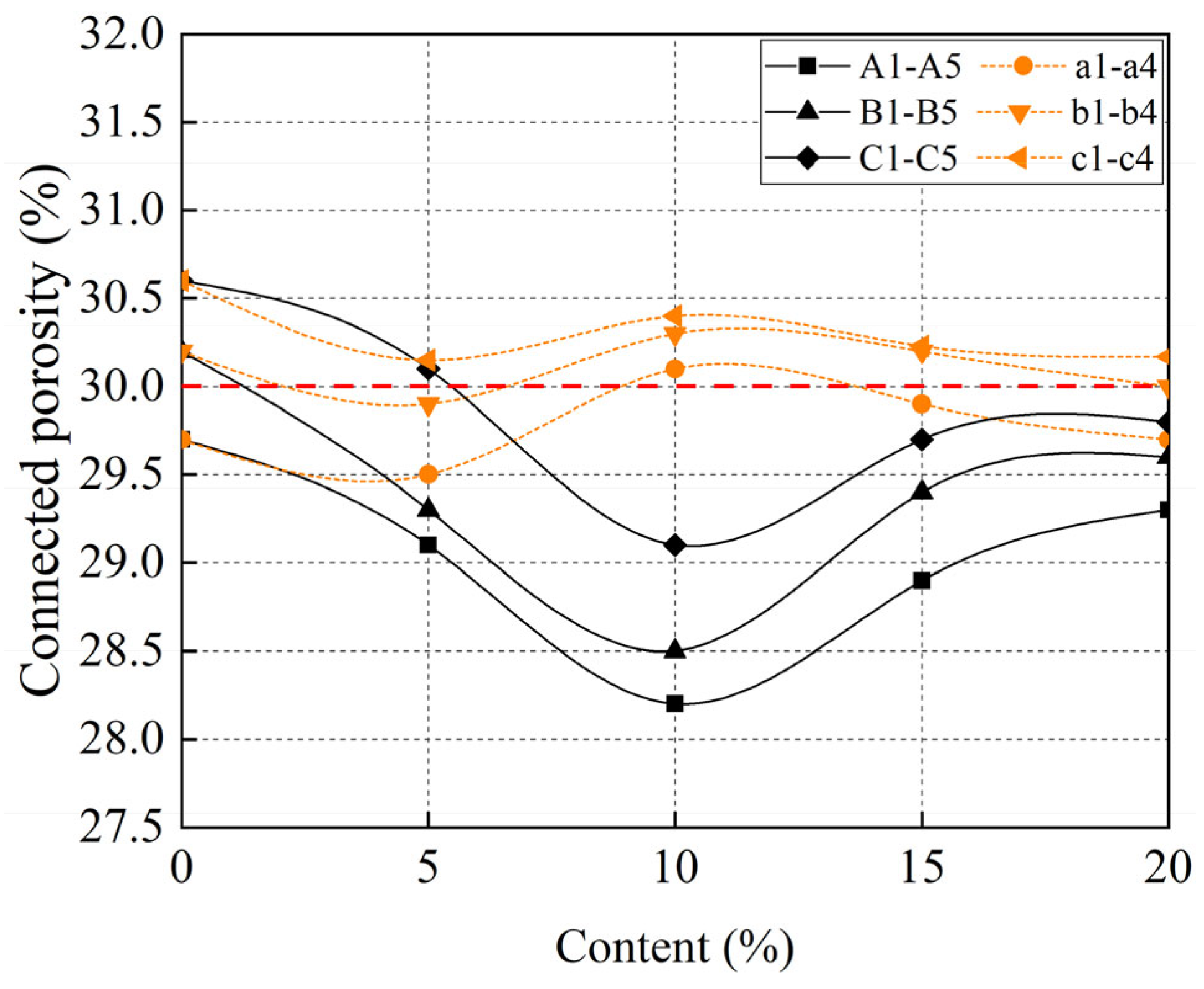




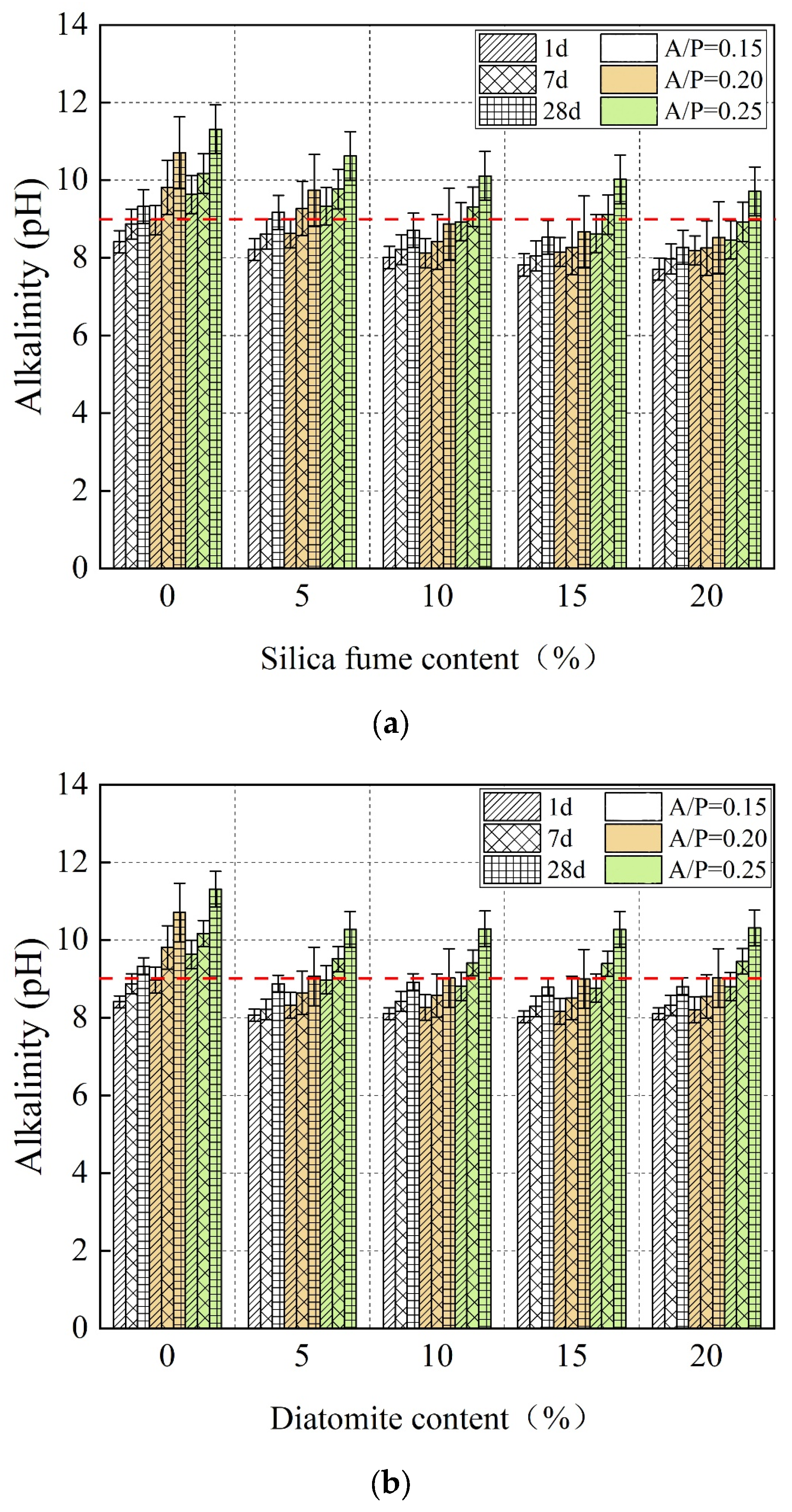


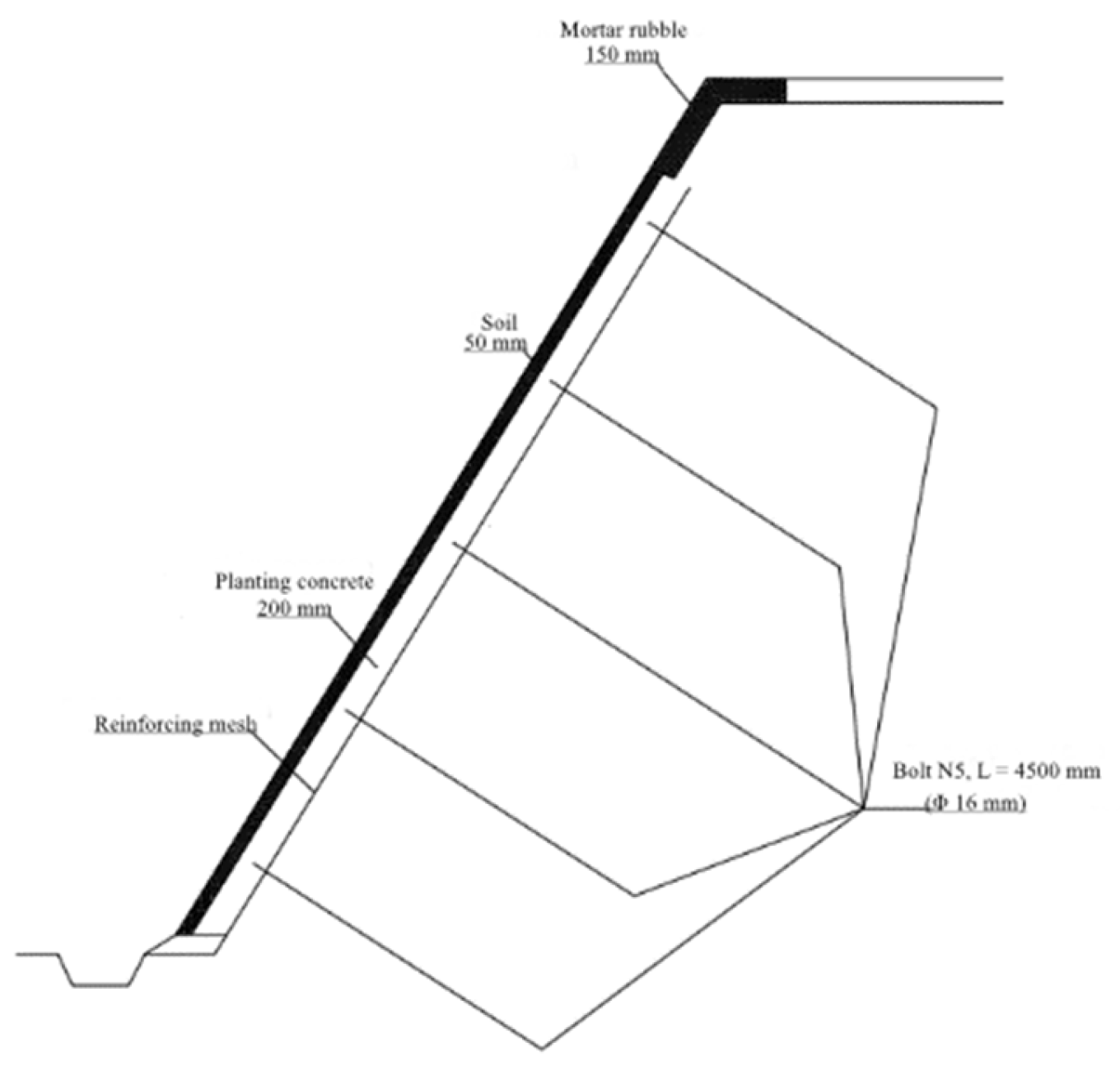


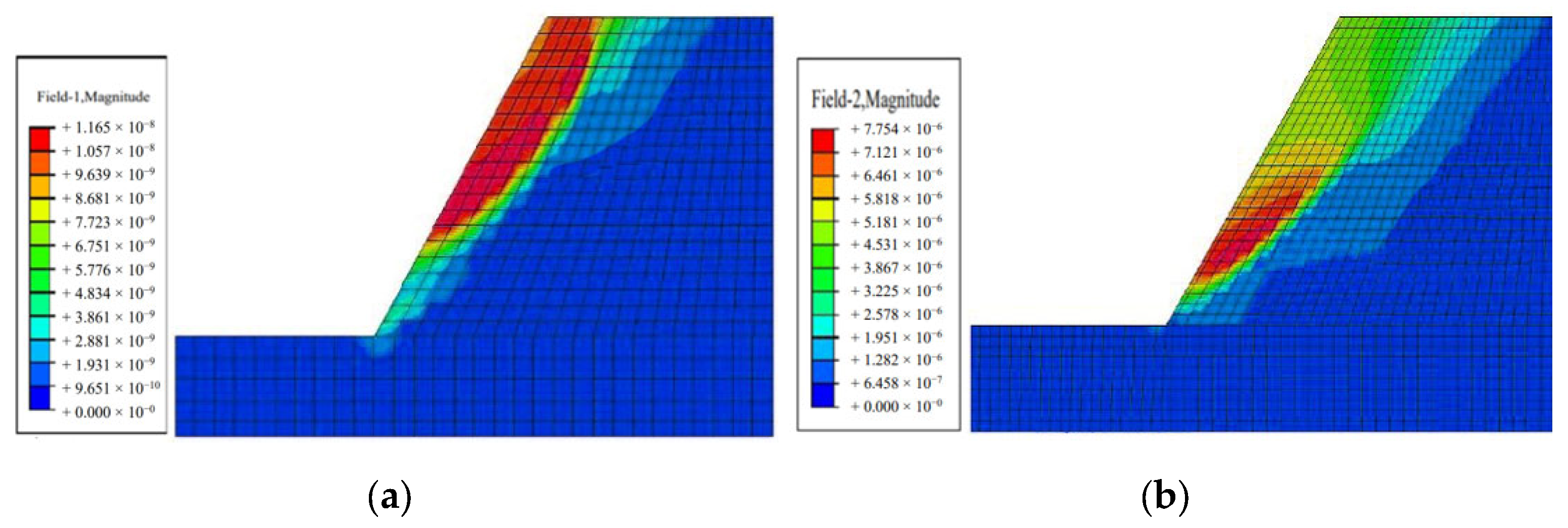
| Red Mud (%) | BFS (%) | DA (%) | SF (%) | |
|---|---|---|---|---|
| SiO2/% | 26.8 | 34.5 | 82.3 | 94.8 |
| Al2O3/% | 24.0 | 17.7 | 6.7 | 0.81 |
| CaO/% | 7.0 | 34.0 | 0.79 | 1.86 |
| Fe2O3/% | 26.8 | 1.03 | 1.98 | 0.08 |
| MgO/% | - | 6.01 | 0.34 | 0.65 |
| Na2O/% | 11.8 | - | - | 0.45 |
| Sample No. | Red Mud (kg/m3) | SF (kg/m3) | DA (kg/m3) | BFS (kg/m3) | Aggregate (kg/m3) | A/P | Water (kg/m3) |
|---|---|---|---|---|---|---|---|
| A1 | 115 | 0 | 0 | 115 | 1500 | 0.15 | 45.75 |
| A2 | 115 | 11.5 | 0 | 103.5 | 1500 | 0.15 | 45.75 |
| A3 | 115 | 23 | 0 | 92 | 1500 | 0.15 | 45.75 |
| A4 | 115 | 34.5 | 0 | 80.5 | 1500 | 0.15 | 45.75 |
| A5 | 115 | 46 | 0 | 69 | 1500 | 0.15 | 45.75 |
| a1 | 115 | 0 | 11.5 | 103.5 | 1500 | 0.15 | 45.75 |
| a2 | 115 | 0 | 23 | 92 | 1500 | 0.15 | 45.75 |
| a3 | 115 | 0 | 34.5 | 80.5 | 1500 | 0.15 | 45.75 |
| a4 | 115 | 0 | 46 | 69 | 1500 | 0.15 | 45.75 |
| B1 | 115 | 0 | 0 | 115 | 1500 | 0.20 | 38.00 |
| B2 | 115 | 11.5 | 0 | 103.5 | 1500 | 0.20 | 38.00 |
| B3 | 115 | 23 | 0 | 92 | 1500 | 0.20 | 38.00 |
| B4 | 115 | 34.5 | 0 | 80.5 | 1500 | 0.20 | 38.00 |
| B5 | 115 | 46 | 0 | 69 | 1500 | 0.20 | 38.00 |
| b1 | 115 | 0 | 11.5 | 103.5 | 1500 | 0.20 | 38.00 |
| b2 | 115 | 0 | 23 | 92 | 1500 | 0.20 | 38.00 |
| b3 | 115 | 0 | 34.5 | 80.5 | 1500 | 0.20 | 38.00 |
| b4 | 115 | 0 | 46 | 69 | 1500 | 0.20 | 38.00 |
| C1 | 115 | 0 | 0 | 115 | 1500 | 0.25 | 30.25 |
| C2 | 115 | 11.5 | 0 | 103.5 | 1500 | 0.25 | 30.25 |
| C3 | 115 | 23 | 0 | 92 | 1500 | 0.25 | 30.25 |
| C4 | 115 | 34.5 | 0 | 80.5 | 1500 | 0.25 | 30.25 |
| C5 | 115 | 46 | 0 | 69 | 1500 | 0.25 | 30.25 |
| c1 | 115 | 0 | 11.5 | 103.5 | 1500 | 0.25 | 30.25 |
| c2 | 115 | 0 | 23 | 92 | 1500 | 0.25 | 30.25 |
| c3 | 115 | 0 | 34.5 | 80.5 | 1500 | 0.25 | 30.25 |
| c4 | 115 | 0 | 46 | 69 | 1500 | 0.25 | 30.25 |
| Unit Weight (kn/m3) | Saturated Volume Water Rate/% | Saturated Permeability Coefficient/(m/s) | Cohesion/kPa | Internal Friction Angle/(°) | Elastic Modulus/Kn/m3 | Poisson’s Ratio | |
|---|---|---|---|---|---|---|---|
| Soil | 19.2 | 25 | 5.4 × 10−6 | 24 | 32.2 | 4000 | 0.3 |
| PC | 20 | - | - | - | - | 16,000 | 0.2 |
Disclaimer/Publisher’s Note: The statements, opinions and data contained in all publications are solely those of the individual author(s) and contributor(s) and not of MDPI and/or the editor(s). MDPI and/or the editor(s) disclaim responsibility for any injury to people or property resulting from any ideas, methods, instructions or products referred to in the content. |
© 2023 by the authors. Licensee MDPI, Basel, Switzerland. This article is an open access article distributed under the terms and conditions of the Creative Commons Attribution (CC BY) license (https://creativecommons.org/licenses/by/4.0/).
Share and Cite
Chen, W.; Li, J. Effects of Different Silicon Sources on the Properties of Geopolymer Planting Concrete Mixed with Red Mud. Sustainability 2023, 15, 4427. https://doi.org/10.3390/su15054427
Chen W, Li J. Effects of Different Silicon Sources on the Properties of Geopolymer Planting Concrete Mixed with Red Mud. Sustainability. 2023; 15(5):4427. https://doi.org/10.3390/su15054427
Chicago/Turabian StyleChen, Wei, and Jiusu Li. 2023. "Effects of Different Silicon Sources on the Properties of Geopolymer Planting Concrete Mixed with Red Mud" Sustainability 15, no. 5: 4427. https://doi.org/10.3390/su15054427
APA StyleChen, W., & Li, J. (2023). Effects of Different Silicon Sources on the Properties of Geopolymer Planting Concrete Mixed with Red Mud. Sustainability, 15(5), 4427. https://doi.org/10.3390/su15054427





